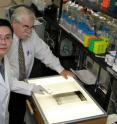Discovery challenges fundamental tenet of cancer biology
Yale researchers have identified an unusual molecular process in normal tissues that causes RNA molecules produced from separate genes to be clipped and stitched together. The discovery that these rearranged products exist in normal as well as cancerous cells potentially complicates the diagnosis of some cancers and raises the possibility that anti-cancer drugs like Gleevec could have predictable side effects. The work is reported in the journal Science.
"Our findings are surprising because we identified in normal cells certain types of gene products— so called chimeric RNAs and proteins—thought to be found only in cancerous cells or in cells on their way to becoming cancerous," said Jeffrey Sklar, professor of pathology and laboratory medicine at Yale School of Medicine, and senior researcher on the study.
Chimeric proteins are considered to be key factors that drive many forms of cancer. They arise from chromosome abnormalities in which segments of the chromosomes are rearranged. At the sites where chromosome segments reattach, genes fuse giving rise to chimeric RNA, which in turn is used to construct the chimeric protein. Gleevec, a highly successful new anti-cancer drug, was developed to target the chimeric protein product of one such gene fusion.
Sklar's group earlier discovered that a particular gene fusion, with its associated chimeric RNA and protein, is the probable cause of certain endometrial cancers. Unexpectedly, they also found the same chimeric RNA and protein in healthy uterine tissue — where the chromosomes and genes showed no abnormalities.
"Extensive experiments on the normal tissues and cultured cells from those tissues indicated to us that a previously little-known process, the direct splicing together of two RNAs from separate genes—or trans-splicing—is responsible for producing the chimeras," said Sklar.
They also found that level of the chimeric molecules in normal cells was decreased by elevated estrogen and increased by reduced oxygen — conditions that control the synchronized cyclic behavior of normal cells that line the inside of the uterus.
These observations suggest that trans-splicing between the RNAs might be common in other normal tissues, because gene fusions have been identified in cancers that arise in many tissues.
"These findings may bring new insights into how cancers operate. It seems that rather than scrambling chromosomes to invent new genes, cancers mimic normal cellular processes, but in an exaggerated and unregulated fashion. You might say that cancers are clever but not very original," said Yale Research scientist Hui Li, lead author of the paper.
According to the researchers, these results indicate that caution should be exercised in using chimeric gene products as markers for cancer, as is widely done now in cancer diagnosis. Additionally, cancer drugs that target products of chromosomal abnormalities may have varying degrees of toxicity because those same targets may be present in normal cells due to the trans-splicing of RNA.
Source: Yale University
Other sources
- Discovery Challenges Fundamental Tenet Of Cancer Biologyfrom Science DailyThu, 4 Sep 2008, 21:35:20 UTC
